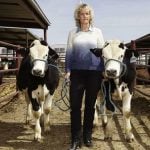Resilient food systems are essential to our country’s environmental, economic and social well-being, and the challenges faced by our growers and producers are growing exponentially.
“We have climate change, more extreme weather, droughts and more people to feed on the earth,” says Xiuming Hao, senior research scientist at Agriculture and Agri-Food Canada.
Hao has teamed up with Youbin Zheng, professor at the University of Guelph’s School of Environmental Sciences and other industry partners on their “AI Farming” project to develop innovative agricultural technologies that will make growing food more environmentally and economically sustainable.
“If we can produce much more food per unit of land area, then we can have a farm in the desert, near the North Pole and in remote communities,” says Hao. “And we can improve food security and quality.”
The “AI Farming” group, spearheaded by Zheng and Hao, is one of 11 teams of grantees from across the country who are participating in the Weston Family Foundation’s Homegrown Innovation Challenge. The Homegrown Innovation Challenge is investing $33 million towards research and innovations that will solve the interconnected challenges related to reliably, sustainably, and competitively producing berries out of season and at scale.
With annual import values of $475 million, berries have massive untapped potential for domestic operations—but they are also among the most challenging crops to grow in Canada, thanks to a short growing season and limited shelf life as well as vulnerability to pests and diseases. The challengers’ strategies must be cost effective, have a negligible impact on the environment, be suitable for diverse Canadian geographic regions and be at least partially adaptable to other crops.
Now in the second of three phases, the Challenge has granted each team up to $1 million to create small-scale, proof-of-concept solutions over 18 months. The Challenge is all about collaboration, as reflected in the teams’ public-private partnerships that bring together growers, producers, farmers, engineers, scientists, technologists, and other innovators who have taken a leadership role in the future of food production.
Allyson MacLean’s “True North Berries” project unites her Symbiosis Lab at the University of Ottawa with Fieldless, an indoor agriculture grower out of Cornwall, and Ceragen, a biotechnology company based in Waterloo. A key objective is to determine how bacteria could serve as beneficial microorganisms for strawberries, boosting productivity, taste, and health benefits.
“I am most excited to identify microbial inoculants that are specific to strawberries,” MacLean says. “What are they? Can they be leveraged to other crops? There’s such potential for sculpting the microbiome to help plants grow.”

Dr. Allyson MacLean, University of Ottawa and Jon Lomow, Fieldless
Ontario Tech University’s team, led by Osman Hamid, is working with Willowtree Farm in Port Perry to tackle the high energy demands of indoor growing environments. Their project centres around an energy-efficient, controlled environment agriculture facility (EE-CEAF) that combines a thermally enhanced greenhouse with cooling and heat systems powered by waste material.
The Toronto Metropolitan University grantees are running their SMART raspberry growing system on a triboelectric generator that harvests energy from static electricity, while the team at Western University is using photovoltaic technology to turn solar energy into electricity for their indoor vertical farm. The adjustable solar photovoltaic arrays also serve as a shield for their additional outdoor farm, protecting plants from extreme weather and reducing water needs.
Mike Dixon’s team, also from the University of Guelph, is employing vertical farming methods inside advanced greenhouses that maximize available sunlight and extend the growing season through customized LED lighting.
“You can take full advantage of the sun when it’s there,” says Thomas Graham, a professor in the school of environmental science who researches how to grow food in extreme environments, including space. “But with the hybridized system, we’re getting the best of both worlds.”
Other ground-breaking innovations include pest-resistant growing mediums, genetically-engineered microbes that promote plant growth and temperature resistance, and biosensors that monitor plant health in real time.
Hao and Zheng have paired their biosensors with an artificial-intelligence-powered autonomous farming system that updates data every five minutes, responding with adjustments to variables such as temperature and carbon dioxide concentration.
“People might think a greenhouse is easy,” Zheng says. “Just turn on the heat and the plants will grow, but it’s not like that. You have to create an ideal environment. There’s temperature, light, CO2. There’s how much water and nutrients you provide to the plants. And these are associated with costs.”
The top four grantee teams moving to the third phase of the Challenge will receive $5 million each across three years to build and demonstrate their system at farm scale in Canada. The best overall team of this phase will be awarded $1 million and $1 million will be awarded to the team that has demonstrated the greatest breakthrough vis-à-vis its technology.
“Perhaps the best thing about the project is being able to fail quickly, learn quickly, and fix it quickly,” says Hamid of Ontario Tech. “I know it sounds weird to be excited about failure, but I think the process is going to be more than fast—it’s going to be hypersonic.”
To learn more about the Homegrown Innovation Challenge and the projects visit: https://homegrownchallenge.ca/.







